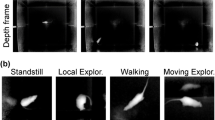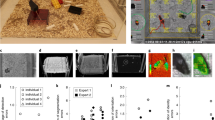Abstract
A rodent behavior analysis system is presented, capable of automated tracking, pose estimation, and recognition of nine behaviors in freely moving animals. The system tracks three key points on the rodent body (nose, center of body, and base of tail) to estimate its pose and head rotation angle in real time. A support vector machine (SVM)-based model, including label optimization steps, is trained to classify on a frame-by-frame basis: resting, walking, bending, grooming, sniffing, rearing supported, rearing unsupported, micro-movements, and “other” behaviors. Compared to conventional red-green-blue (RGB) camera-based methods, the proposed system operates on 3D depth images provided by the Kinect infrared (IR) camera, enabling stable performance regardless of lighting conditions and animal color contrast with the background. This is particularly beneficial for monitoring nocturnal animals’ behavior. 3D features are designed to be extracted directly from the depth stream and combined with contour-based 2D features to further improve recognition accuracies. The system is validated on three freely behaving rats for 168 min in total. The behavior recognition model achieved a cross-validation accuracy of 86.8% on the rat used for training and accuracies of 82.1 and 83% on the other two “testing” rats. The automated head angle estimation aided by behavior recognition resulted in 0.76 correlation with human expert annotation.

Top view of a rat freely behaving in a standard homecage, captured by Kinect-v2 sensors. The depth image is used for constructing a 3D topography of the animal for pose estimation, behavior recognition, and head angle calculation. Results of the processed data are displayed on the user interface in various forms.










Similar content being viewed by others
References
Tecott LH, Nestler EJ (2004) Neurobehavioral assessment in the information age. Nat Neurosci 7:462–466
van Meer PJK, Graham ML, Schuurman H (2015) The safety, efficacy and regulatory triangle in drug development: impact for animal models and the use of animals. Eur J Pharmacol 759:3–13
Baker M (2011) Animal models: inside the minds of mice and men. Nature 475:123–128
Rat Genome Sequencing Project Consortium (2004) Genome sequence of the Brown Norway rat yields insights into mammalian evolution. Nature 428:493–521
Shi Q, Miyagishima S, Fumino S et al (2010) Development of a cognition system for analyzing rat’s behaviors. In: IEEE Int Conf Robotics and Biomimetics (ROBIO), pp 1399–1401
Shi Q, Ishii H, Konno S et al (2012) Image processing and behavior planning for robot-rat interaction. In: IEEE RAS & EMBS Int. Conf. Biomedical Robotics and Biomechatronics (BioRob), pp 967–973
Jhuang H, Garrote E, Yu X, Khilnani V, Poggio T, Steele AD, Serre T (2010) Automated home-cage behavioural phenotyping of mice. Nat Commun 1(68):1–9
Burgos-Artizzu XP, Dollár P, Lin D et al (2012) Social behavior recognition in continuous videos. In: IEEE Conf. Computer vision and pattern recognition (CVPR 2012), pp 1322–1329
van Dam EA, van der Harst JE, ter Braak CJF et al (2013) An automated system for the recognition of various specific rat behaviours. J Neurosci Methods 218(2):214–224
Patel TP, Gullotti DM, Hernandez P, O'Brien WT, Capehart BP, Morrison B, Bass C, Eberwine JE, Abel T, Meaney DF (2014) An open-source toolbox for automated phenotyping of mice in behavioral tasks. Front Behav Neurosci 8:349
Brodkin J, Frank D, Grippo R, Hausfater M, Gulinello M, Achterholt N, Gutzen C (2014) Validation and implementation of a novel high-throughput behavioral phenotyping instrument for mice. J Neurosci Methods 224:48–57
Lorbach M, Kyriakou EI, Poppe R et al (2017) Learning to recognize rat social behavior: Novel dataset and cross-dataset application. J Neurosci Methods. in press, available online
Ren Z, Noronha A, Ciernia AV et al (2017) Who moved my cheese? Automatic annotation of rodent behaviors with convolutional neural networks. In: IEEE Winter Conf. Applications computer vision (WACV), pp 1277–1286
Crispim-Junior CF, de Azevedo FM, Marino-Neto J (2017) What is my rat doing? Behavior understanding of laboratory animals. Pattern Recogn Lett 94:134–143
Han J, Shao L, Xu D, Shotton J (2013) Enhanced computer vision with Microsoft Kinect sensor: a review. IEEE Trans Cybern 43(5):1318–1334
Hu M, Chen C, Cheng W et al (2015) Real-time human movement retrieval and assessment with Kinect sensor. IEEE Trans Cybern 45(4):742–753
Whitmire E, Latif T, Bozkurt A (2013) Kinect-based system for automated control of terrestrial insect biobots. In: Int. Conf. IEEE EMBC, pp 1470–1473
Wiltschko AB, Johnson MJ, Iurilli G, Peterson RE, Katon JM, Pashkovski SL, Abraira VE, Adams RP, Datta SR (2015) Mapping sub-second structure in mouse behavior. Neuron 88(6):1121–1135
Lee B, Kiani M, Ghovanloo M (2014) A smart homecage system with 3D tracking for long-term behavioral experiments. In: Int. Conf. IEEE EMBC, pp 2016-2019
Lee B, Kiani M, Ghovanloo M (2015) A smart wirelessly powered homecage for long-term high-throughput behavioral experiments. IEEE Sensors J 14(9):4905–4916
Ou-Yang TH, Tsai ML, Yen CT, Lin TT (2011) An infrared range camera-based approach for three-dimensional locomotion tracking and pose reconstruction in a rodent. J Neurosci Methods 201(1):116–123
Matsumoto J, Urakawa S, Takamura Y, Malcher-Lopes R, Hori E, Tomaz C, Ono T, Nishijo H (2013) A 3D-video-based computerized analysis of social and sexual interactions in rats. PLoS One 8(10):e78460
Matsumoto J, Nishimaru H, Ono T, Nishijo H (2017) 3D-video-based computerized behavioral analysis for in vivo neuropharmacology and neurophysiology in rodents. In: Philippu A (ed) In Vivo Neuropharmacology and Neurophysiology. Neuromethods, vol 121. Humana Press, New York
Nakamura A, Funaya H, Uezono N, Nakashima K, Ishida Y, Suzuki T, Wakana S, Shibata T (2015) Low-cost three-dimensional gait analysis system for mice with an infrared depth sensor. Neurosci Res 100:55–62
Xu C, Govindarajan LN, Zhang Y, Cheng L (2017) Lie-X: depth image based articulated object pose estimation, tracking, and action recognition on lie groups. Int J Comput Vis (IJCV) 123(3):454–478
Rezaei B, Lowe J, Yee JR et al (2016) Non-contact automatic respiration monitoring in restrained rodents. In: Int. Conf. IEEE EMBC, pp 4946–4950
Rezaei B, Huang X, Yee JR, Ostadabbas S (2017) Long-term non-contact tracking of caged rodents. In: 42nd IEEE Int. Conf. Acoustics, Speech and Signal Processing (ICASSP’17), pp 1952–1956
Monteiro JP, Oliveira HP, Aguirar P, Cardoso JS (2014) A depth-map approach for automatic mice behavior recognition. In: IEEE Int. Conf. Image Processing (ICIP), pp 2261–2265
Hong W, Kennedy A, Burgos-Artizzu XP, Zelikowsky M, Navonne SG, Perona P, Anderson DJ (2015) Automated measurement of mouse social behaviors using depth sensing, video tracking, and machine learning. PNAS 112(38):E5351–E5360
Wang Z, Mirbozorgi SA, Ghovanloo M (2015) Towards a Kinect-based behavior recognition and analysis system for small animals. In: IEEE biomed. Circ. Sys. Conf. (BioCAS), pp 683–686
Jia Y, Wang Z, Canales D et al (2016) A wirelessly-powered homecage with animal behavior analysis and closed-loop power control. In: Int Conf IEEE EMBC, pp 6323–6326
Jia Y, Mirbozorgi SA, Wang Z, Ghovanloo M (2017) Position and orientation insensitive wireless power transmission for EnerCage-Homecage system. IEEE Trans Biomed Eng 64(10):2439–2449
Gonzalez RC, Woods RE (2008) Digital image processing, 3rd edn. Prentice Hall, Upper Saddle River
Lorbach M, Poppe R, van Dam EA et al (2015) Automated recognition of social behavior in rats: the role of feature quality. In: Int. Conf. Image analysis processing (ICIAP 2015), pp 565–574
Fuzesi T, Daviu N, Cusulin JIW et al (2016) Hypothalamic CRH neurons orchestrate complex behaviours after stress. Nat Commun 7:1–13
Hsu CW, Lin CJ (2002) A comparison of methods for multiclass support vector machines. IEEE Trans Neural Netw 13(2):415–425
Chang CC, Lin CJ (2011) LIBSVM: a library for support vector machines. ACM Trans Intell Syst Technol 2(2):1–27
Kelland MD, Asdourian D, Kelland DZ (1988) Inhibition and excitation of neck and shoulder muscles during unilateral electrical stimulation of the rat neostriatum. Behav Brain Res 30:1–13
Chen L, Chan SCY, Yung WH (2002) Rotational behavior and electrophysiological effects induced by GABAB receptor activation in rat globus pallidus. Neuroscience 144(2):417–425
Goutte C, Gaussier E (2005) A probabilistic interpretation of precision, recall and F-score, with implication for evaluation. In: 27th European Conf. Advances inform. Retrieval research, pp 345–359
Acknowledgements
This work was supported in part by the National Institutes of Health award 1R21EB018561 and the National Science Foundation under award ECCS-1407880 and ECCS-1408318. The authors would like to thank Prof. Rainnie and members of his lab at the Emory University Department of Psychiatry for their assistance in conducting the in vivo experiments.
Author information
Authors and Affiliations
Corresponding author
Ethics declarations
The experiment, which was conducted as part of the evaluation of the EnerCage-HC2 system, was approved by the Institutional Animal Care and Use Committees (IACUC) at Emory University and Georgia Tech.
All procedures performed in studies involving animals were in accordance with the ethical standards of the institution or practice at which the studies were conducted.
Rights and permissions
About this article
Cite this article
Wang, Z., Mirbozorgi, S.A. & Ghovanloo, M. An automated behavior analysis system for freely moving rodents using depth image. Med Biol Eng Comput 56, 1807–1821 (2018). https://doi.org/10.1007/s11517-018-1816-1
Received:
Accepted:
Published:
Issue Date:
DOI: https://doi.org/10.1007/s11517-018-1816-1




